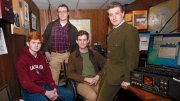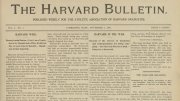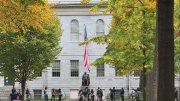As Leo Koerner ’26 trudged upstairs with Declan Deady ’27, a three-minute timer started in his head. Once Koerner opened the door to the “radio shack,” its walls paneled with wood veneer and plastered with Soviet-era maps, he had just a few moments to convince Deady that this endeavor was magical.
Koerner is trying to revive the Harvard Wireless Club, a group of amateur (“ham”) radio enthusiasts. Unlike the student DJs at WHRB, Koerner’s crew operates two-way radios: essentially superpowered, imprecise walkie-talkies. Harvard’s ham radio station is the sixth-oldest in the country, founded in 1909. But this 116-year-old club is at risk of disappearing. Few young people express interest in amateur radio, with waves (generally) full of old men. Can Koerner keep this time capsule alive?
To do so, he will need club members. Enter Deady. That November evening, Koerner—whose cotton blazers and thickly-striped button-downs evoke dapper college students of yore—plopped down before an array of antiquated machines, bathed in the subtle aroma of cigarettes smoked decades ago. With the press of a button, he rotated the four-story antenna atop 6 Linden Street (just south of Massachusetts Avenue and Widener Library). He twisted a dial, adjusting the frequency. The speaker hummed to life. At first, it sounded like C-3PO, but soon Southern drawls started poking through. Koerner tapped a foot pedal, calling into the ether: “Whiskey One Alpha Foxtrot, is this frequency in use?”
The minutes ticked by, but Deady’s attention did not fade: he was enchanted. Finally, a voice crackled. The pair struck up a conversation with a Georgia man. Their exchange wasn’t profound—they traded call signs and promised to send each other postcards—but it is that connection, across place, age, and background, that Koerner and Deady craved. Koerner earned himself a new member.
Koerner is not the type of person one would expect to tinker with machines. He studies medieval history, not radio physics. But when he was a high school sophomore, the COVID-19 pandemic suddenly left him with a lot of free time. The future president of the John Adams Society and the Harvard Republican Club grew curious about private, decentralized communications systems. Ham radio has “no wires between people…no network towers,” he says. With a small battery-operated device, he could talk to anyone in the world: true freedom.
Koerner’s first ham radio was a walkie-talkie-sized device that beamed a signal to a repeater atop a roof of an MIT building. But he soon learned that he would need a Federal Communications Commission (FCC) certification to play with his new toy. (Ham radio can interfere with emergency and military communications if improperly used.) So he studied for the FCC’s three-round, 1,000-question exam, learning a second language in which “CQ” means calling all stations, “59” asks for a signal report, and “73s” is goodbye.
Once certified, Koerner climbed mountains in western Massachusetts, where his family hunkered down during the pandemic, and beamed his voice across the world. He chatted with Venezuelan dissidents and Cuban citizens, conversations he might never get to have in person.
Arriving on campus in August 2022, Koerner stumbled upon the Wireless Club’s website, untouched for five years. Recent alumni granted Koerner the presidency, as he was the only on-campus member. Now, he feels a historian’s pull toward preservation. The radio room and the storage space above are like miniature museums of Harvard radio, chock-full of “incredibly valuable” machinery.
Koerner would not be the first student to revive the club. When Douglas Maggs ’17 arrived on campus, a chemistry department technician named Bill Collins was running the club because no undergraduates were involved. Over four years, Maggs built up the group, generating revenue by selling wares at MIT radio “swap meets,” helping two dozen students get FCC-certified, running contests to see who could connect with the most states, and volunteering radio services during the Boston Marathon, the Jimmy Fund Walk, and the Head of the Charles Regatta. (Ham radio works even when cell towers are overwhelmed.)
Now, Koerner must again build the club from nothing. He convinced Mallinckrodt professor of physics Melissa Franklin and emeritus professor of physics and electrical engineering Paul Horowitz to serve as faculty sponsors. Harvard facilities workers are helping Koerner clean the cluttered storage room, where he hopes many students will soon gather and discuss ham radio. If he builds it, will they come?
Deady, one class younger, might be Koerner’s best hope. Though he is not yet licensed, he may be the only other student whose two-way radio knowledge rivals Koerner’s. How many other undergraduates have favorite radio frequencies? (Deady’s are HF and SINCGARS.)
Deady spent four years in the U.S. Army, including a long stint working with radios. That role had drawbacks, like lugging a 30-pound radio in his 110-pound pack. But it had benefits, too. “I got to go to the radio cage,” he says, “where the door was closed and people weren’t yelling at me.”
He grew to love the tactile nature of two-way radio. Echoing science fiction writer Arthur C. Clarke, he argues that modern communications technology is so advanced that it is “indistinguishable from magic.” But an iPhone does not feel magical. “We need to see the green dial showing output quality,” the dual English and Slavic literature concentrator says. “We need to be spinning dials and flipping switches because it feels real.”
Beyond the technology, Deady is drawn to ham radio by the conversation: he sees it as a hobby that’s all about connecting people. “If I get on the radio, the first question I ask is, ‘Who are you?’” he explains, his voice buttery like a radio commentator’s. “That’s what the call sign is. Tell me who you are. Tell me where you are.” After establishing where their conversation partner is, ham radio users generally describe what equipment they are using and how long they have been on the radio. Radio chats are “lower than small talk,” he says. They are “nothing talk.”
Even if the conversations are mundane, Deady feels they are worth pursuing. He sees ham radio as a final refuge from the technological world. “Most people, myself included, have precious few places where anyone wants to know anything,” he says. “I don’t care what equipment someone is using to communicate with me on the radio.…While I don’t care what the answer is, I care that there is an answer.”
The coming year will be crucial for the club’s survival. Koerner has just one more year until he graduates. Can he pass the torch to the next generation of Harvard ham radio operators? No matter how much Koerner waxes poetic about his hobby, he says the best way to get someone hooked is to hop on the radio and make a quick connection. So, he will bring more friends up the stairs of 6 Linden and start the three-minute timer anew, hoping others feel the magic, too.









